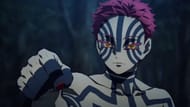In the Demon Slayer series, various items hurt the demons. These include sunlight, Nichirin swords used by the Demon Slayers, and the Wisteria plant. Among these, there is the possibility of another item: Ultraviolet lamps, which were used in the 1930s as disinfectants. Since the workings of UV lamps are related to those of the sun, they could have also been used by warriors to fight demons.
The series is set during the Taisho era, two decades before the launch of UV lamps. If the series were set in the 1930s, it would be easier to deduce that the current series would have finished long ago, owing to the use of UV lamps.
Advantage of UV lamps in the Demon Slayer series

The series is set during Japan’s Taishō period, a significant historical era marked by a shift in the nation’s political power. This setting is clearly reflected in the presence of traditional elements like minka, pagodas, and cherry blossoms. The Taishō period, which lasted from July 30, 1912, to December 25, 1926, serves as a backdrop for the series' arcs.

Despite the real-life timeframe of these 14 years, the series draws a realistic comparison to the era, except for the addition of demons. In the series, demons are vulnerable to sunlight, which creates a unique challenge for the slayers. If the storyline had been set in the 1930s, the introduction of the first ultraviolet (UV) commercial lamps could have provided an advantage.
These lamps, used to disinfect and kill microorganisms, have a similar effect to sunlight. Consequently, UV lamps could have been an effective tool for defeating demons and Kibutsuji Muzan.
Apart from sunlight, what other substances are demons weak against in the Demon Slayer series?

Apart from sunlight, demons are weak against Nichirin swords and the Wisteria plant in the series.
Nichirin Swords are unique blades crafted from an alloy of Scarlet Crimson Iron Sand and Scarlet Crimson Ore, which have extensively absorbed sunlight. This absorption allows the swords to decapitate demons effectively, instantly killing them upon contact.

However, there are notable exceptions to this lethal capability. demons such as Muzan Kibutsuji, Akaza, and Kokushibo have managed to survive decapitation by Nichirin Swords.
Akaza and Kokushibo, in particular, survived through sheer willpower. In another case, the sibling demons Daki and Gyutaro required simultaneous decapitation to prevent either from reattaching their heads and regenerating.
Hantengu presents a unique scenario where the initial beheading triggers his Blood Demon Art, manifesting his primal emotions as a defensive mechanism. These emotional manifestations are impervious to death as long as Hantengu lives. He was ultimately killed only after exhausting his power and summoning his last emotion, leaving him weakened and vulnerable.

Coming to the demons' next weakness, Wisteria is a plant known for its toxicity to demons. It releases a scent that repels demons, and extracts from the plant are used to create a potent poison capable of killing lesser demons in small amounts.
This poison played a crucial role in the death of Upper Rank Two demon Doma, who ingested over 700 times the lethal dosage to be effectively killed. Wisteria's properties make it a valuable resource for demon slayers, providing a means to combat and eradicate demonic threats.
Final thoughts

If the series had been set two decades later, the introduction of UV lamps would have provided a significant advantage to the Demon Slayers, potentially shortening the series dramatically by offering an effective and readily available method to eradicate demons and defeat Kibutsuji Muzan.
Related links:
- All 6 Infinity Castle Fights in Demon Slayer, ranked chronologically
- Demon Slayer: Did Sumiyoshi Kamado know Sun Breathing? Explained
- The curse of the Demon Slayer Mark might not be as certain as fans were led to believe
